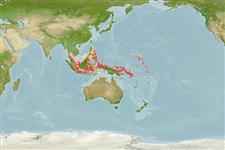>
Ophidiiformes (Cusk eels) >
Dinematichthyidae (Viviparous brotula)
Etymology: Diancistrus: Greek, di = two + Greek, agkistron = hook (Ref. 45335); altidorsalis: Name from Latin 'altus' meaning high and 'dorsalis' meaning neck, referring to its high-necked profile..
More on authors: Schwarzhans, Møller & Nielsen.
Environment: milieu / climate zone / depth range / distribution range
экология
морской ассоциированный с рифами; пределы глубины 15 - 20 m (Ref. 57884). Tropical
распространение
страны | регионы FAO | Ecosystems | места находок | Point map | интродукции | Faunafri
Western Pacific: Indonesia, New Guinea, Sabah to the Solomons, including Sta. Cruz Islands.
Size / Вес / Возраст
Maturity: Lm ? range ? - ? cm
Max length : 10.2 cm SL самец/пол неопределен; (Ref. 57884)
Краткое описание
морфология | морфометрия
членистые (мягкие) лучи спинного плавника (общее число): 76-85; членистые (мягкие) лучи анального плавника: 59 - 68; позвонки: 43 - 45. Diagnosis: Vertebrae 11+32-34=43-45, dorsal fin rays 76-85, anal fin rays 59-68; eyes large (at least 2.5% SL); outer pseudoclasper large, broad, ear-lobe shaped; inner pseudoclasper a fleshy appendix at the anterior-inner rim of the outer pseudoclasper, without supporter; large scale patch on operculum above opercular spine (6–9 scales) and 1 to 3 isolated scales below opercular spine; head profile strongly ‘high-necked / hump-backed’; color yellow in live specimens (Ref. 57884).
Large dominating individuals were observed to make attacks toward smaller fish, which were hiding below rocks or any other shelter provided. One male was observed to flip backward the cover of the copulatory organ so that the organ can be exposed while swimming (Ref. 57884). Solitary inhabitant of coral reef crevices to at least 20m depth, cryptic (Ref 90102).
Life cycle and mating behavior
половая зрелость | размножение | нерест | икра | Fecundity | личинки
Schwarzhans, W., P.R. Møller and J.G. Nielsen, 2005. Review of the Dinematichthyini (Teleostei, Bythitidae) of the Indo-West-Pacific. Part I. Diancistrus and two new genera with 26 new species. The Beagle, Records of the Museum and Art Galleries of the Northern Territory 21:73-163. (Ref. 57884)
Статус Красного Списка МСОП (Ref. 130435)
Угроза для людей
Harmless
Использование человеком
дополнительная информация
народные названиясинонимыобмен веществхищникиэкотоксикологияразмножениеполовая зрелостьнерестSpawning aggregationFecundityикраРазвитие икры
Возраст/РазмерыростЗависимость между длиной и массой телаЗависимость между длинамиРазмерный составморфометрияморфологияличинкидинамика численности личинокпополнениечисленностьBRUVS
ссылкиаквакультура (рыбоводство)особенности рыбоводствастепень растяжениягенетикаElectrophoresesнаследуемостьболезниобработкаNutrientsMass conversion
соавторыизображенияStamps, Coins Misc.звукиCiguateraскоростьтип плаванияжаберная областьOtolithsмозгзрение
инструменты
Специальные отчеты
Скачать в формате XML
ресурсы в Интернет
Estimates based on models
Preferred temperature (Ref.
123201): 27.9 - 29.3, mean 28.8 °C (based on 1452 cells).
Phylogenetic diversity index (Ref.
82804): PD
50 = 0.5000 [Uniqueness, from 0.5 = low to 2.0 = high].
Bayesian length-weight: a=0.00389 (0.00180 - 0.00842), b=3.12 (2.94 - 3.30), in cm total length, based on all LWR estimates for this body shape (Ref.
93245).
Trophic level (Ref.
69278): 3.4 ±0.5 se; based on size and trophs of closest relatives
Fishing Vulnerability (Ref.
59153): Low vulnerability (10 of 100).
